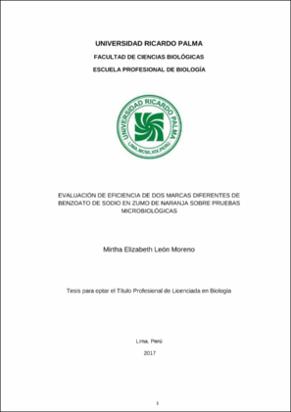Mostrar el registro sencillo del ítem
Evaluación de eficiencia de dos marcas diferentes de benzoato de sodio en zumo de naranja sobre pruebas microbiológicas
| dc.contributor.advisor | Kam Torres, Yuri | |
| dc.contributor.author | León Moreno, Mirtha | |
| dc.date.accessioned | 2017-05-31T16:30:10Z | |
| dc.date.available | 2017-05-31T16:30:10Z | |
| dc.date.issued | 2017 | |
| dc.identifier.uri | https://hdl.handle.net/20.500.14138/908 | |
| dc.description.abstract | La presente investigación tuvo por objetivo evaluar la eficiencia de dos marcas de benzoato de sodio de diferente procedencia (americana y china) en zumo de naranja sobre pruebas microbiológicas a condiciones de temperatura de ambiente (24ºC ± 1 ºC) y pH de 3 a 3.5; puesto que, el benzoato de sodio es uno de los conservantes más usados en la industria alimentaria y según experiencias en el rubro, se percibe que el benzoato de procedencia china no es tan eficiente a comparación del americano. El estudio fue realizado en el laboratorio de Microbiología de la Facultad de Ciencias Biológicas- URP, siendo el experimento diseñado en una matriz que contenga al benzoato de sodio de las dos procedencias (china y americana) y se pueda comparar por cada grupo de muestras con inóculo puro de levadura (Saccharomyces sp.), extraído del lavado de naranja; y con inóculo puro de bacteria (Escherichia coli). De los resultados, se observa que las muestras con benzoato de sodio de ambas procedencias no tuvieron crecimiento microbiano alguno, sólo desarrollaron las que no tenían la sustancia conservadora. De ello se concluye que no hay diferencias entre el benzoato de procedencia china con el de procedencia americana. The objective of the present investigation was to evaluate the efficiency of two brands of sodium benzoate of different origin (American and Chinese) in orange juice on microbiological tests at ambient temperature (24ºC ± 1 ºC) and pH of 3 to 3.5; Since sodium benzoate is one of the most used preservatives in the food industry and according to experiences in the field, it is perceived that benzoate of Chinese origin is not as efficient in comparison to the American. The study was carried out in the laboratory of Microbiology of the Faculty of Biological Sciences - URP. The experiment was designed in a matrix containing sodium benzoate from both sources (Chinese and American) and can be compared for each group of samples Pure yeast inoculum (Saccharomyces sp.), extracted from the orange wash; And with pure inoculum of bacteria (Escherichia coli). From the results, it was observed that the samples with sodium benzoate of both origins did not have any microbial growth, only developed those that did not have the conservative substance. From this it is concluded that there is no difference between benzoate of Chinese origin and that of American origin. | es_ES |
| dc.description.sponsorship | Submitted by Wong Rafael (rafel_wl@hotmail.com) on 2017-05-31T16:30:10Z No. of bitstreams: 1 León_me_pdf.pdf: 1155321 bytes, checksum: 77d94739ed1b076f34e0398a23fae85f (MD5) | es_ES |
| dc.description.sponsorship | Made available in DSpace on 2017-05-31T16:30:10Z (GMT). No. of bitstreams: 1 León_me_pdf.pdf: 1155321 bytes, checksum: 77d94739ed1b076f34e0398a23fae85f (MD5) Previous issue date: 2017 | es_ES |
| dc.description.uri | Tesis | es_ES |
| dc.format | application/pdf | |
| dc.language.iso | spa | |
| dc.publisher | Universidad Ricardo Palma - URP | es_ES |
| dc.rights | info:eu-repo/semantics/openAccess | |
| dc.rights.uri | https://creativecommons.org/licenses/by-nc-nd/4.0/ | |
| dc.source | Repositorio Institucional - URP | es_ES |
| dc.subject | Benzoato de Sodio | es_ES |
| dc.subject | Citrus sinensis | es_ES |
| dc.subject | Jugos de Frutas y Vegetales | es_ES |
| dc.subject | Conservantes de Alimentos | es_ES |
| dc.title | Evaluación de eficiencia de dos marcas diferentes de benzoato de sodio en zumo de naranja sobre pruebas microbiológicas | es_ES |
| dc.type | info:eu-repo/semantics/bachelorThesis | |
| thesis.degree.discipline | Biología | es_ES |
| thesis.degree.grantor | Universidad Ricardo Palma. Facultad de Ciencias Biológicas. Escuela Profesional de Biología | es_ES |
| thesis.degree.level | Título Profesional | es_ES |
| thesis.degree.name | Licenciada en Biología | es_ES |
| dc.publisher.country | PE | es_ES |
| renati.type | https://purl.org/pe-repo/renati/type#tesis | |
| renati.level | https://purl.org/pe-repo/renati/nivel#tituloProfesional | |
| renati.discipline | 511206 | |
| dc.type.version | info:eu-repo/semantics/publishedVersion |
Ficheros en el ítem
Este ítem aparece en la(s) siguiente(s) colección(ones)
-
Biología [176]


